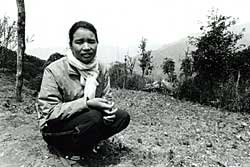 Emma Raynes was studying Nepali and anthropology in Nepal during the spring of 2003, when she hit upon the idea of giving point-and-shoot cameras to Nepali women to help her see things she couldn't.
Emma Raynes was studying Nepali and anthropology in Nepal during the spring of 2003, when she hit upon the idea of giving point-and-shoot cameras to Nepali women to help her see things she couldn't.
Raynes says she chose Nepali women for her project because she found that women's voices were rarely acknowledged here. "I was searching for more knowledge about Nepali culture but also because I wanted to empower my subjects by giving them a way to speak about their lives with images," she says.
The women that she decided to work with were friends, neighbours or people she met while traveling in Nepal. They were of various ages, castes, classes and places. Most of the women are from Kathmandu and the village of Tangting near Pokhara. She gave each subject a camera, showed them how to use the viewfinder and the flash. She then asked them to photograph things that were important to them and things that they thought Americans did not understand about their lives.
A few days later, Raynes would retrieve the cameras and make double prints at a local photo shop. Finally, she returned to the women's homes, gave them copies of their photos and discussed what they photographed. She told them she would take their pictures back to America to show them to family and friends. Some said: "Lau ta, tapai American haru lai sab kura bujhaidinus."
Rayne's exhibition of Collaborative Portraits include both her black-and-white photographs and colour pictures taken by Nepali women. The portraits have captions with words that Raynes translated from Nepali. They were exhibited in three locations in the US during the past year: Bowdoin College in Brunswick in Maine, Buckingham Brown and Nichols School in Cambridge Massachusetts, and Soundtrack Studio in Boston. The project was funded by a fellowship from Bowdoin College and earned the Martel Prize from the Bowdoin College Art Department.
[email protected]
Bijaya Laxmi Gurung 11 years old

Bijaya lives in Tangting, a hill village near Pokhara. She is the daughter of Tangting's midwife. She says that when she grows up, she wants to study in Pokhara and become a nurse like her mother. These are the photographs that she took.
Sumita Magar 18 years old

Sumita works at the lodge for trekkers that her father owns in Gorepani. Her father owns a lodge for trekkers. Sumita cooks in the kitchen during trekking season and goes to school in the nearest town during the rest of the year.

"The mountains are very important to me because they bring water to the people in my village.and water brings us life."

"I taught myself how to cook American food because that is what the tourists like to eat."

"I took this picture of my school book because school is the most important part of my life. I want to be a nurse like my mother. Her hands are also in this picture."

"This where my mother does puja. I don't do puja but I still believe."

Nita Rai is my Nepali sister. When I was not in class, studying Nepali language, Nita and I washed clothes and watched TV together. She really liked to watch WWF wrestling and Hindi soap operas. These are Nita's photographs.

"My mother made me marry young so that my grandmother could live to see my sons."

"This is a Nepali washing machine."


